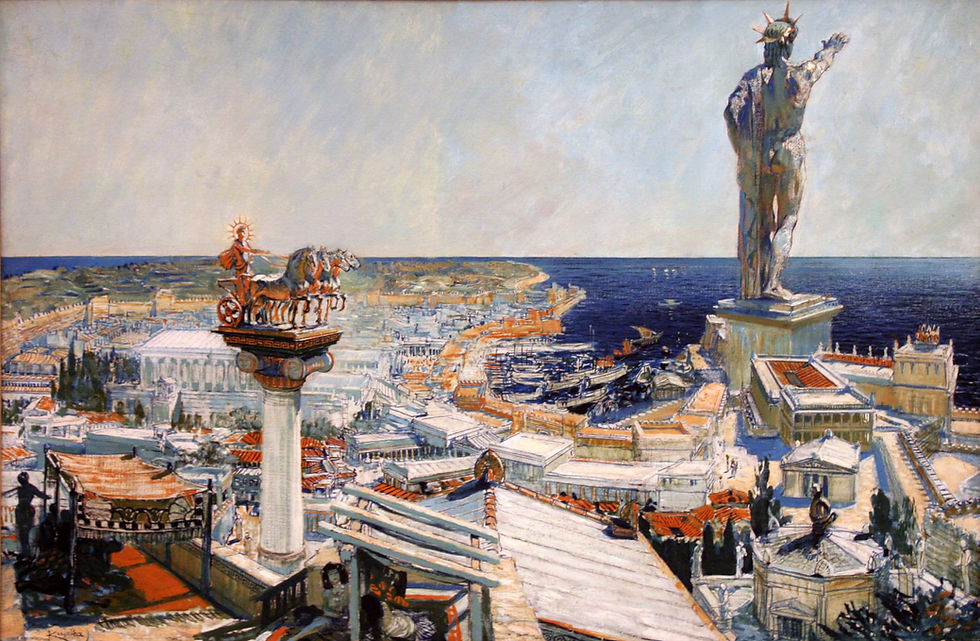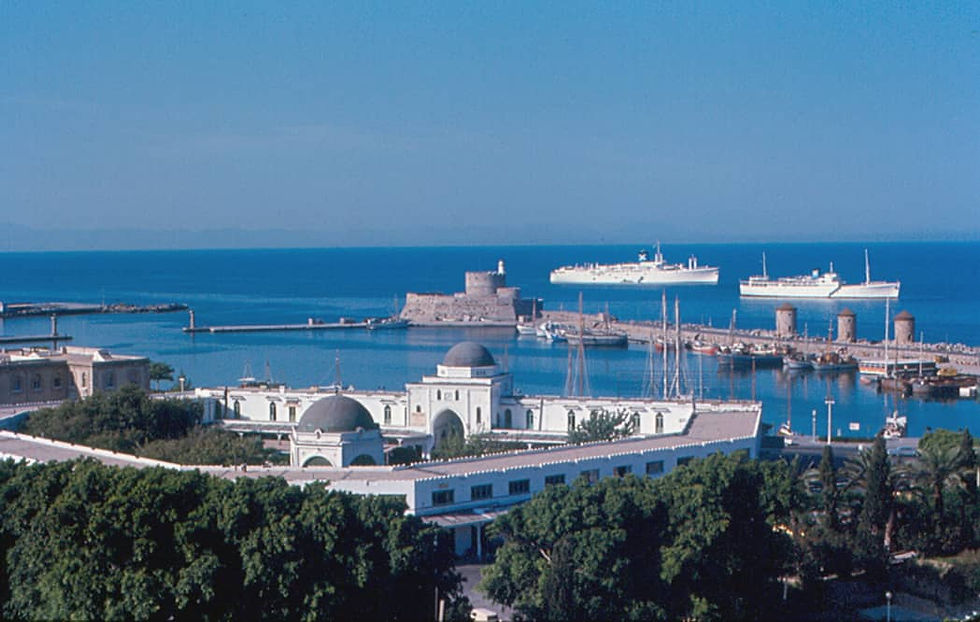
This guide brings forth a captivating journey through time to explore one of the most remarkable wonders of the ancient world – the Colossus of Rhodes.
Standing tall and proud at the entrance of the Rhodes town harbor, this colossal statue has left an unforgettable mark on history and, to this day, continues to captivate the imagination of travellers, history enthusiasts, and holidayers coming to Rhodes.
In this guide, we will delve into the fascinating history, construction, and legacy of the Colossus of Rhodes, as well as provide practical information for those planning to visit this once giant of the ancient world.

The Incredible History of the Colossus of Rhodes
Centuries ago, roughly in 280 BC, on the ancient Greek island of Rhodes, the Colossus statue was erected as a symbol of the island's recent victory.
Rhodes had successfully defended itself against the Macedonian military leader Demetrius Poliocretes, who had besieged the Rhodians with his naval and army forces.
The statue served as a proud testament to the island's resilience and celebration of their hard-won freedom against Poliocretes. It very quickly gained widespread fame, and the islanders themselves came to be known as Colossaeans.
You might also like:

The Magnitude of the Colossus
The Colossus of Rhodes was an engineering marvel of its time, similar in size to the modern Statue of Liberty.
Rising to an impressive height of approximately 33 meters, it was the largest statue in the ancient world.
Constructed using iron tie rods and brass sheets for the outer skin, the statue exuded grandeur and awe-inspiring beauty. Despite the disadvantages brought by its colossal size, the statue was meticulously designed to endure the test of time and the elements.

The Construction Process
The enormous task of sculpting the Colossus was given to Chares of Lindos, a student of the renowned sculptor Lysippus. Construction of the colossus started in 292 BC and lasted for several years. The statue was cast in sections horizontally, with each segment being covered in rubble to provide stability and support.
The inner structure consisted of a mixture of iron and stone, meticulously brought together to reinforce the bronze outer shell. The craftsmanship and attention to detail displayed in its construction were a testament to the skill and artistry of the ancient Greeks.
However, the exact appearance of the Colossus of Rhodes remains a subject of speculation. It is believed that the statue depicted the sun god Helios in a powerful pose.
Modern representations of Helios on Rhodian currency indicate to us that the statue may have featured a crown of pointed sunbeams and wavy hair, adorned with bronze or silver flames. The statue's face and head, however, are better known, thanks to surviving depictions from the time.

The Location of the Colossus: An Uncertain Debate
The exact location of the Colossus of Rhodes within the Rhodes harbor has been a controversial point of debate in the last years.
The most common school of thought indicated that the colossus was placed between the edges of each side of the marina, with boats passing through its legs as they entered. This notion is supported in many popular paintings of the Colossus of Rhodes.
However, following new discoveries, this is now being challenged by archeologists. It is now believed by many influential historians and archeologists that the statue was placed either on the eastern promontory of the Mandraki harbor or further inland, overlooking the harbor entrance.
Whatever its true location may have been, the Colossus of Rhodes undoubtedly held a breathtaking presence over the island.

The Demise of a Legend: The Colossus' Fall
Tragically, the Colossus of Rhodes fell in 226 BC when a devastating earthquake struck the island.
The statue, weakened at the knees and broke under the force of nature, leaving the once-majestic monument in ruins. While the statue lay in pieces, it continued to inspire wonder and admiration, even in its fallen state. The Rhodians, guided by an oracle's advice, chose not to rebuild the statue, honoring the divine will.
Today, the Colossus of Rhodes may be lost to history, but its history, legacy, and significance lives on in the hearts and minds of those who appreciate its grandeur.
For history enthusiasts seeking to immerse themselves in the wonders of ancient Greece, a visit to Rhodes is truly a unique opportunity to experience the rich history and architectural marvels of the past. Walking in the footsteps of ancient civilizations, one can't help but be amazed by the remnants of this magnificent one out of the seven Wonders of the Ancient World.

Planning Your Visit to Rhodes
If you're considering a trip to Rhodes to observe the many remnants and historical sites of ancient Greece, here are some practical tips to help you make the most of your journey:
Best Time to Visit Rhodes
Rhodes has a Mediterranean climate, with relatively mild winters and hot summers.
The best time to visit is during the spring and autumn months (April to June and September to October), when the weather is pleasant, and tourist crowds are relatively smaller. These months are also the best times for grabbing discounted prices at hotels.
Getting There
Rhodes is well-connected by air, with regular flights from major European cities. Diagoras International Airport, located near the capital city of Rhodes, is the main gateway to the island. From the airport, you can reach the town of Rhodes by taxi or public transportation. Or, if you're arriving by sea, there are ferry connections from various Greek islands and mainland ports.
Exploring Rhodes
In addition to the Colossus of Rhodes, the island offers a wealth of historical and cultural attractions. Explore the medieval Old Town of Rhodes, a UNESCO World Heritage site, with its impressive fortifications and narrow cobblestone streets. Visit the ancient Acropolis of Rhodes, where you can admire panoramic views of the island. Don't miss the Archaeological Museum of Rhodes, which houses a collection of artifacts from various periods of Rhodes' history.
Captivating Coastal Beauty
Rhodes is renowned for its stunning beaches and crystal-clear waters. Spend some time relaxing on the golden sands of Faliraki Beach or exploring the secluded coves of Anthony Quinn Bay. For a touch of adventure, try water sports such as snorkeling or windsurfing.
Local Cuisine and Delicacies
Indulge in the flavors of Rhodes by sampling the island's traditional cuisine. Taste mouthwatering dishes such as moussaka, souvlaki, and fresh seafood. Don't forget to try local specialties like pitaroudia (chickpea fritters) and pasteli (sesame seed bars).
Colossus of Rhodes: Frequently Asked Questions
Is the Colossus of Rhodes still standing?
No, the Colossus of Rhodes collapsed during a major earthquake in 226 BC that ravaged the island. It was never rebuilt. Only fragments remain, leaving its exact appearance to speculation.
Can visitors see the remnants of the Colossus?
Unfortunately not. There are no visible remains of the Colossus of Rhodes today. However, a visit to Rhodes offers the opportunity to explore the island's rich history and see other ancient sites from the time.
Where was the Colossus of Rhodes located?
The exact location of the Colossus within the Rhodes harbor is hotly debated among historians and archeologists. It is believed to have been situated either on the eastern promontory of the Mandraki harbor or further inland, overlooking the harbor entrance.
How tall was the Colossus of Rhodes?
The Colossus of Rhodes stood approximately 33 meters (108 ft) tall, making it one of the tallest statues of the ancient world.
Can I visit the island of Rhodes year-round?
Yes, Rhodes can be visited year-round. However, the best time to visit is during the spring and autumn months when the weather is pleasant and tourist crowds are smaller. It is advised to book ahead to avoid unexpected delays.
Are there hotels available near the Colossus of Rhodes?
While there are no hotels specifically near the Colossus site, the town of Rhodes offers a wide range of hotels and accommodations to suit every budget and preference.
Are there any other ancient sites to visit in Rhodes?
Yes, Rhodes is home to numerous ancient sites, including the Acropolis of Rhodes, the Ancient Stadium, and the Temple of Apollo. These sites are very popular travel destinations among enthusiasts of ancient history.
What is the currency used in Rhodes?
The currency used in Rhodes is the Euro (€). Credit cards are widely accepted, and ATMs are readily available for cash withdrawals. There are also many currency exchange points around the island.
How can I reach Rhodes?
Rhodes is easily accessible by air, with regular flights from major European cities. It is also possible to reach the island by ferry from various Greek islands and mainland ports. Travel from Turkey is also possible via the daily ferry routes to and from Marmaris.
Is English widely spoken in Rhodes?
Yes, English is widely spoken in Rhodes, particularly in tourist areas. However, it is always helpful to learn a few basic Greek phrases to enhance your travel experience.